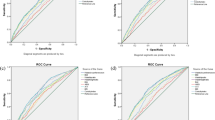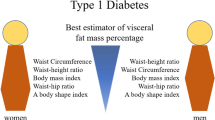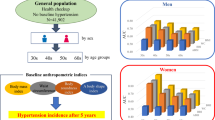Abstract
OBJECTIVE: To investigate waist circumference, waist-to-hip ratio, body mass index (BMI), weight and hip circumference as risk factors for type 2 diabetes in Aboriginal Australians.
DESIGN: Community-based cross-sectional study.
SUBJECTS: In total, 915 Australian Aboriginal adults (age: 18–74 y) from a remote Aboriginal community in the Northern Territory of Australia.
MEASUREMENTS: Body size measurements included waist circumference, waist-to-hip ratio, BMI, weight and hip circumference. Diabetes status was determined according to medical history and fasting and 2-h postload plasma glucose values. Logistic regression was used to calculate odds ratio for diabetes associated with 1 standard deviation (s.d.) increase in a body size measurement. The areas under the ROC curves of five body size measurements were calculated and compared.
RESULTS: Risk of diabetes increased with increasing levels of body size. ORs (95% CI) for diabetes with adjustment for age and sex were 2.16 (1.75, 2.66), 1.80 (1.49, 2.17), 1.41 (1.17, 1.71), 1.81 (1.51, 2.19) and 1.84 (1.50, 2.24) associated with 1 s.d. increase in waist circumference, BMI, weight, waist-to-hip ratio, and hip circumference, respectively. The area under the ROC curve for waist circumference was significantly higher than those for other measurements.
CONCLUSION: Waist circumference is the best body size measurement in predicting diabetes in Aboriginal people.
This is a preview of subscription content, access via your institution
Access options
Subscribe to this journal
Receive 12 print issues and online access
$259.00 per year
only $21.58 per issue
Buy this article
- Purchase on Springer Link
- Instant access to full article PDF
Prices may be subject to local taxes which are calculated during checkout

Similar content being viewed by others
References
Wei M, Gaskill SP, Haffner SM, Stern MP . Waist circumference as the best predictor of noninsulin dependent diabetes mellitus (NIDDM) compared to body mass index, waist/hip ratio and other anthropometric measurements in Mexican Americans—a 7-year prospective study. Obes Res 1997; 5: 16–23.
Rosenthal AD, Jin F, Shu XO, Yang G, Elasy TA, Chow WH, Ji BT, Xu HX, Li Q, Gao YT, Zheng W . Body fat distribution and risk of diabetes among Chinese women. Int J Obes Relat Metab Disord 2004; 28: 594–599.
Wang Z, Hoy W . Waist circumference, body mass index, hip circumference and waist-to-hip ratio as predictors of cardiovascular disease in Aboriginal people. Eur J Clin Nutr 2004; 58: 888–893.
Snijder MB, Dekker JM, Visser M, Bouter LM, Stehouwer CD, Kostense PJ, Yudkin JS, Heine RJ, Nijpels G, Seidell JC . Associations of hip and thigh circumferences independent of waist circumference with the incidence of type 2 diabetes: the Hoorn Study. Am J Clin Nutr 2003; 77: 1192–1197.
Snijder MB, Zimmet PZ, Visser M, Dekker JM, Seidell JC, Shaw JE . Independent and opposite associations of waist and hip circumferences with diabetes, hypertension and dyslipidemia: the AusDiab Study. Int J Obes Relat Metab Disord 2004; 28: 402–409.
Seidell JC, Han TS, Feskens EJ, Lean ME . Narrow hips and broad waist circumferences independently contribute to increased risk of non-insulin-dependent diabetes mellitus. J Intern Med 1997; 242: 401–406.
Wang Z, Hoy W . Hypertension, dyslipidaemia, body mass index, diabetes and smoking status in Aboriginal Australians in a remote community. Ethn Dis 2003; 13: 324–330.
Norgan NG . Interpretation of low body mass indices: Australian aborigines. Am J Phys Anthropol 1994; 94: 229–237.
Diagnosis and classification of diabetes mellitus. Diabetes Care 2004; 27 (Suppl 1): S5–S10.
Hanley JA, McNeil BJ . The meaning and use of the area under a receiver operating characteristic (ROC) curve. Radiology 1982; 143: 29–36.
DeLong ER, DeLong DM, Clarke-Pearson DL . Comparing the areas under two or more correlated receiver operating characteristic curves: a nonparametric approach. Biometrics 1988; 44: 837–845.
StataCorp. Stata Statistical Software: Release 8.0. College Station. Stata Corporation: TX; 2003.
Foucan L, Hanley J, Deloumeaux J, Suissa S . Body mass index (BMI) and waist circumference (WC) as screening tools for cardiovascular risk factors in Guadeloupean women. J Clin Epidemiol 2002; 55: 990–996.
Lean ME, Han TS, Morrison CE . Waist circumference as a measure for indicating need for weight management. BMJ 1995; 311: 158–161.
Despres JP, Lemieux I, Prud'homme D . Treatment of obesity: need to focus on high risk abdominally obese patients. BMJ 2001; 322: 716–720.
de Vegt F, Dekker JM, Jager A, Hienkens E, Kostense PJ, Stehouwer CD, Nijpels G, Bouter LM, Heine RJ . Relation of impaired fasting and postload glucose with incident type 2 diabetes in a Dutch population: The Hoorn Study. JAMA 2001; 285: 2109–2113.
Pouliot MC, Despres JP, Lemieux S, Moorjani S, Bouchard C, Tremblay A, Nadeau A, Lupien PJ . Waist circumference and abdominal sagittal diameter: best simple anthropometric indexes of abdominal visceral adipose tissue accumulation and related cardiovascular risk in men and women. Am J Cardiol 1994; 73: 460–468.
Vadstrup ES, Petersen L, Sorensen TI, Gronbaek M . Waist circumference in relation to history of amount and type of alcohol: results from the Copenhagen City Heart Study. Int J Obes Relat Metab Disord 2003; 27: 238–246.
Lemieux S, Prud'homme D, Tremblay A, Bouchard C, Despres JP . Anthropometric correlates to changes in visceral adipose tissue over 7 years in women. Int J Obes Relat Metab Disord 1996; 20: 618–624.
Warne DK, Charles MA, Hanson RL, Jacobsson LT, McCance DR, Knowler WC, Pettitt DJ . Comparison of body size measurements as predictors of NIDDM in Pima Indians. Diabetes Care 1995; 18: 435–439.
Daniel M, Rowley KG, McDermott R, O'Dea K . Diabetes and impaired glucose tolerance in Aboriginal Australians: prevalence and risk. Diabetes Res Clin Pract 2002; 57: 23–33.
Seidell JC, Perusse L, Despres JP, Bouchard C . Waist and hip circumferences have independent and opposite effects on cardiovascular disease risk factors: the Quebec Family Study. Am J Clin Nutr 2001; 74: 315–321.
Dunstan DW, Zimmet PZ, Welborn TA, Cameron AJ, Shaw J, de Courten M, Jolley D, McCarty DJ . The Australian Diabetes, Obesity and Lifestyle Study (AusDiab)—methods and response rates. Diabetes Res Clin Pract 2002; 57: 119–129.
Acknowledgements
We especially thank the Aboriginal people who participated in this study; the Tiwi Health Board, the Tiwi Land Council and the Tiwi clinics for their help and support. This project was supported by the National Health & Medical Research Council of Australia.
Author information
Authors and Affiliations
Corresponding author
Rights and permissions
About this article
Cite this article
Wang, Z., Hoy, W. Body size measurements as predictors of type 2 diabetes in Aboriginal people. Int J Obes 28, 1580–1584 (2004). https://doi.org/10.1038/sj.ijo.0802771
Received:
Revised:
Accepted:
Published:
Issue Date:
DOI: https://doi.org/10.1038/sj.ijo.0802771
Keywords
This article is cited by
-
Physical Activity and Fitness of First Nations Youth in a Remote and Isolated Northern Ontario Community: A Needs Assessment
Journal of Community Health (2016)
-
Diabetes and Impaired Fasting Glucose Prediction Using Anthropometric Indices in Adults from Maracaibo City, Venezuela
Journal of Community Health (2016)
-
Prediction of cardiovascular disease risk using waist circumference among Aboriginals in a remote Australian community
BMC Public Health (2015)
-
Participant characteristics associated with greater reductions in waist circumference during a four-month, pedometer-based, workplace health program
BMC Public Health (2011)
-
Study protocol: a pragmatic randomised controlled trial of a 12-week physical activity and nutritional education program for overweight Aboriginal and Torres Strait Islander women
BMC Public Health (2011)



